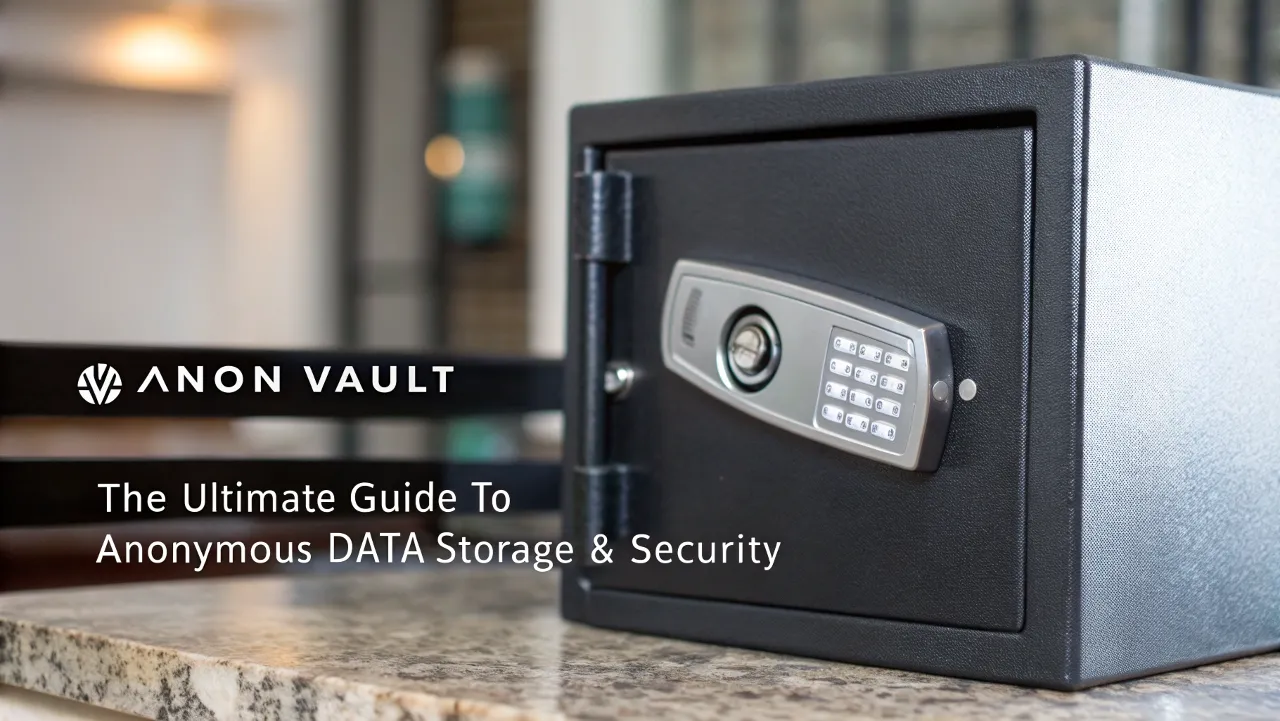Table of Contents
In the digital age, protecting personal and sensitive data has become more critical than ever. From privacy breaches to identity theft, safeguarding online information is at the forefront of everyone’s minds.
This is where Anon Vault comes into play, a platform designed for truly anonymous, end-to-end encrypted data storage. Originally launched in 2019, Anon Vault has quickly risen to prominence for its robust security features and privacy guarantees.
In this comprehensive guide, we’ll explore the evolution of Anon Vault, its core security architecture, how to set it up, and why it remains one of the best solutions for anonymous data storage today.
The Evolution of Anon Vault: From Launch to Cutting-Edge Privacy
Anon Vault’s journey began in 2019 when OpenPrivacy Labs introduced the platform as the first of its kind to offer crypto-shredding capabilities for data storage. As the digital landscape evolved, so did Anon Vault’s features.
By 2021, it introduced zero-knowledge metadata protection and integrated distributed ledger anchoring to further secure users’ data. Fast forward to 2023, and the platform expanded to include a mobile client and a Tor hidden-service gateway, ensuring even greater anonymity for users.
In 2025, Anon Vault added a browser extension and enterprise plugin, making it more accessible and easier to integrate into businesses’ daily operations.
What Makes Anon Vault Different? A Deep Dive into Its Security Architecture

Anon Vault isn’t just another encrypted storage solution; it is designed with privacy at its core. The platform employs client-side encryption, meaning that all data is encrypted on the user’s device before being uploaded to the cloud, ensuring that no one but the user can access the data.
One of the standout features is its use of AES-256-GCM for per-file encryption and ChaCha20 for metadata encryption. AES-256 is a widely recognized standard in the encryption industry, offering an exceptionally high level of security. ChaCha20, on the other hand, is used to encrypt metadata, ensuring that information such as file names, timestamps, and sizes remain private.
Key management is another area where Anon Vault excels. The platform uses hierarchical deterministic keys, which are stored exclusively on the user’s device. This setup ensures that the keys never leave the device, preventing any potential breach on the server side.
Privacy & Encryption: Keeping Your Data Safe from Start to Finish
The cornerstone of Anon Vault is its end-to-end encryption. With end-to-end encryption, data is encrypted before it ever leaves the device and remains encrypted throughout its journey to the cloud. This means that only the user holds the decryption key, not even the platform’s servers can access the contents of the data.
Additionally, Anon Vault offers crypto-shredding, a feature that ensures instant data revocation. If a user decides they no longer want to keep a file, they can destroy the encryption key, effectively “shredding” the data without leaving any trace behind.
For those seeking even greater privacy, Anon Vault supports optional integration with the Tor network. This allows users to upload and download their data without revealing their IP address, adding another layer of anonymity.
Also Read: Transforming the Future with Advanced Technology Solved Fact
How to Set Up Anon Vault: A Step-by-Step Guide
Setting up Anon Vault is straightforward, even for those who are new to secure data storage solutions. The installation process involves downloading the application from the official website, followed by configuring your security settings.
Upon installation, users are prompted to generate a master password, which will be used to create the encryption keys. This password is never stored or transmitted to Anon Vault’s servers, ensuring that only the user can decrypt their files. For added security, users can configure two-factor authentication (2FA) and integrate hardware security keys like YubiKey for enhanced protection.
Once set up, users can start uploading files to the platform. Anon Vault allows for both manual uploads and automatic syncing of selected folders. The platform also offers detailed configuration options, allowing advanced users to tweak the system to their specific needs.
Real-World Applications: Who Uses Anon Vault?

Anon Vault isn’t just a tool for tech enthusiasts—its features have made it a vital solution for a wide range of industries and use cases.
Journalism: Secure Whistleblower Submissions
Journalists often face challenges when dealing with sensitive sources and documents. Anon Vault provides a secure environment for whistleblowers to submit files without fear of being traced. The platform’s anonymity features, such as Tor support and crypto-shredding, make it an ideal choice for journalists working in high-risk environments.
Healthcare: Anonymous Record Sharing
In the healthcare industry, HIPAA compliance is a major concern when sharing sensitive patient data. Anon Vault offers a secure, encrypted solution for sharing medical records without compromising patient privacy. Its zero-knowledge encryption ensures that only authorized individuals can access the data, making it an excellent option for healthcare professionals.
Activism: Circumventing Censorship
In regions with heavy censorship, activists and human rights workers often face the risk of having their communications and data intercepted. Anon Vault’s ability to hide user identities and store data in a decentralized, secure environment provides a lifeline for these individuals. The platform’s Tor integration ensures that activists can safely share information without revealing their identity or location.
Performance Benchmarks: Speed and Efficiency
While security is paramount, performance is equally important. Anon Vault delivers strong performance metrics across various storage types. Here’s a breakdown of how it performs:
- Local SSD: Encrypt throughput of 200 MB/s and download latency of 20 ms.
- S3 Backup: Encrypt throughput of 150 MB/s and download latency of 50 ms.
- IPFS Network: Encrypt throughput of 50 MB/s and download latency of 200 ms.
The platform offers impressive speeds, especially when using local SSDs, making it a viable option for individuals who need quick access to their encrypted files.
| Metric | Local SSD | S3 Backup | IPFS Network |
|---|---|---|---|
| Encrypt Throughput | 200 MB/s | 150 MB/s | 50 MB/s |
| Download Latency | 20 ms | 50 ms | 200 ms |
| CPU Overhead | 5% | 8% | 12% |
Anon Vault vs. the Competition: How Does It Compare?
In the crowded market of encrypted storage solutions, Anon Vault stands out for its unique combination of privacy features. While competitors like Cryptomator, SpiderOak, and Tresorit offer end-to-end encryption, Anon Vault distinguishes itself with several advanced features:
- Zero-Knowledge Metadata: Anon Vault offers zero-knowledge metadata protection, unlike some competitors, which means metadata such as file names and timestamps are kept private.
- Tor Support: Anon Vault includes built-in Tor support, allowing users to upload and download files anonymously without exposing their IP address.
- Crypto-Shredding: With crypto-shredding, Anon Vault provides an additional layer of security by ensuring that users can permanently delete files with the destruction of their encryption key.
| Feature | Anon Vault | Cryptomator | SpiderOak | Tresorit |
|---|---|---|---|---|
| E2E Encryption | Yes | Yes | Yes | Yes |
| Zero-Knowledge | Yes | No | Yes | Yes |
| Tor Support | Built-in | No | No | No |
| Crypto-Shredding | Yes | No | No | No |
Advanced Tips & Best Practices for Maximizing Anon Vault

To get the most out of Anon Vault, users can implement several advanced features. For instance, setting up automated key rotation through CI/CD hooks can ensure that encryption keys are rotated regularly for enhanced security. Additionally, integrating a hardware security key like YubiKey can add another layer of protection through two-factor authentication.
For long-term storage, users may also consider using Anon Vault for cold storage vault archiving. This allows users to store data that does not require frequent access while keeping it securely encrypted and inaccessible to unauthorized parties.
Why Anon Vault Remains a Top Choice for Anonymous Data Storage
Anon Vault’s continuous innovation in the field of anonymous data storage and encryption has made it a top contender for anyone serious about protecting their privacy.
Whether you are a journalist, healthcare professional, or activist, Anon Vault offers robust security features that ensure your data remains private, accessible only to you.
With its impressive encryption capabilities, zero-knowledge metadata protection, and seamless integration with Tor, Anon Vault is truly the ultimate solution for anonymous data storage and security. If you haven’t yet, it’s time to download the latest version and explore its powerful features for yourself.
The future of digital privacy is uncertain, but tools like Anon Vault provide a crucial safeguard against the growing threats to our online identities and sensitive data.
FAQs
What is Anon Vault?
Anon Vault is a secure, anonymous data storage platform that offers end-to-end encryption, zero-knowledge metadata protection, and crypto-shredding for ultimate privacy.
How does Anon Vault ensure data privacy?
Anon Vault uses AES-256 encryption, stores keys only on the user’s device, and supports Tor integration for anonymous uploads, guaranteeing complete privacy and security.
Is Anon Vault easy to set up?
Yes, Anon Vault is user-friendly. It offers simple installation, secure password generation, two-factor authentication, and advanced configuration for more experienced users.






